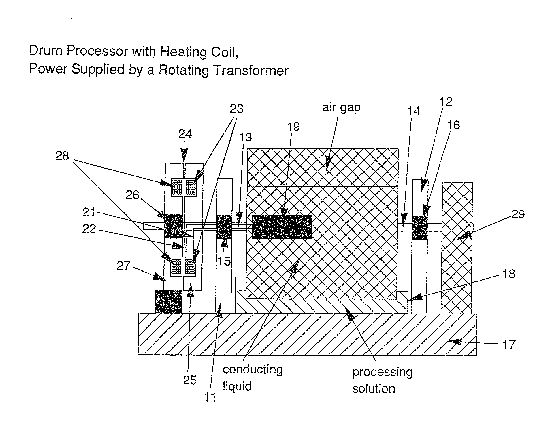Une partie des informations de ce site Web a été fournie par des sources externes. Le gouvernement du Canada n'assume aucune responsabilité concernant la précision, l'actualité ou la fiabilité des informations fournies par les sources externes. Les utilisateurs qui désirent employer cette information devraient consulter directement la source des informations. Le contenu fourni par les sources externes n'est pas assujetti aux exigences sur les langues officielles, la protection des renseignements personnels et l'accessibilité.
L'apparition de différences dans le texte et l'image des Revendications et de l'Abrégé dépend du moment auquel le document est publié. Les textes des Revendications et de l'Abrégé sont affichés :
| (12) Demande de brevet: | (11) CA 2102261 |
|---|---|
| (54) Titre français: | TAMBOUR DE DEVELOPPEMENT |
| (54) Titre anglais: | HOLLOW ROTARY DRUM PROCESSOR |
| Statut: | Réputée abandonnée et au-delà du délai pour le rétablissement - en attente de la réponse à l’avis de communication rejetée |
| (51) Classification internationale des brevets (CIB): |
|
|---|---|
| (72) Inventeurs : |
|
| (73) Titulaires : |
|
| (71) Demandeurs : |
|
| (74) Agent: | GOWLING WLG (CANADA) LLP |
| (74) Co-agent: | |
| (45) Délivré: | |
| (22) Date de dépôt: | 1993-11-02 |
| (41) Mise à la disponibilité du public: | 1994-06-19 |
| Requête d'examen: | 1999-12-21 |
| Licence disponible: | S.O. |
| Cédé au domaine public: | S.O. |
| (25) Langue des documents déposés: | Anglais |
| Traité de coopération en matière de brevets (PCT): | Non |
|---|
| (30) Données de priorité de la demande: | ||||||
|---|---|---|---|---|---|---|
|
ABSTRACT OF THE DISCLOSURE
This specification discloses a hollow rotary drum
processor for bringing a pliable sheet of material,
such as photographic paper, into contact with a
processing liquid, the drum processor having an
interior which is partly filled with liquid and
which is caused or allowed to be uniformly heated.
The interior of the drum processor is closed so
that the liquid is entrapped therein and the energy
to be transmitted by or through it is imparted to
it within the drum processor. The apparatus may
include heating means within the drum processor,
the heating means being operable to heat the liquid
so that the energy is heat energy.
Note : Les revendications sont présentées dans la langue officielle dans laquelle elles ont été soumises.
Note : Les descriptions sont présentées dans la langue officielle dans laquelle elles ont été soumises.

2024-08-01 : Dans le cadre de la transition vers les Brevets de nouvelle génération (BNG), la base de données sur les brevets canadiens (BDBC) contient désormais un Historique d'événement plus détaillé, qui reproduit le Journal des événements de notre nouvelle solution interne.
Veuillez noter que les événements débutant par « Inactive : » se réfèrent à des événements qui ne sont plus utilisés dans notre nouvelle solution interne.
Pour une meilleure compréhension de l'état de la demande ou brevet qui figure sur cette page, la rubrique Mise en garde , et les descriptions de Brevet , Historique d'événement , Taxes périodiques et Historique des paiements devraient être consultées.
| Description | Date |
|---|---|
| Inactive : CIB de MCD | 2006-03-11 |
| Inactive : CIB de MCD | 2006-03-11 |
| Demande non rétablie avant l'échéance | 2004-04-05 |
| Inactive : Morte - Aucune rép. dem. par.30(2) Règles | 2004-04-05 |
| Réputée abandonnée - omission de répondre à un avis sur les taxes pour le maintien en état | 2003-11-03 |
| Inactive : Abandon. - Aucune rép dem par.30(2) Règles | 2003-04-04 |
| Inactive : Dem. de l'examinateur par.30(2) Règles | 2002-12-04 |
| Modification reçue - modification volontaire | 2000-04-03 |
| Lettre envoyée | 2000-01-12 |
| Inactive : Renseign. sur l'état - Complets dès date d'ent. journ. | 2000-01-12 |
| Inactive : Dem. traitée sur TS dès date d'ent. journal | 2000-01-12 |
| Toutes les exigences pour l'examen - jugée conforme | 1999-12-21 |
| Exigences pour une requête d'examen - jugée conforme | 1999-12-21 |
| Demande publiée (accessible au public) | 1994-06-19 |
| Date d'abandonnement | Raison | Date de rétablissement |
|---|---|---|
| 2003-11-03 |
Le dernier paiement a été reçu le 2002-10-11
Avis : Si le paiement en totalité n'a pas été reçu au plus tard à la date indiquée, une taxe supplémentaire peut être imposée, soit une des taxes suivantes :
Les taxes sur les brevets sont ajustées au 1er janvier de chaque année. Les montants ci-dessus sont les montants actuels s'ils sont reçus au plus tard le 31 décembre de l'année en cours.
Veuillez vous référer à la page web des
taxes sur les brevets
de l'OPIC pour voir tous les montants actuels des taxes.
| Type de taxes | Anniversaire | Échéance | Date payée |
|---|---|---|---|
| TM (demande, 4e anniv.) - générale | 04 | 1997-11-03 | 1997-09-19 |
| TM (demande, 5e anniv.) - générale | 05 | 1998-11-02 | 1998-09-25 |
| TM (demande, 6e anniv.) - générale | 06 | 1999-11-02 | 1999-09-17 |
| Requête d'examen - générale | 1999-12-21 | ||
| TM (demande, 7e anniv.) - générale | 07 | 2000-11-02 | 2000-10-03 |
| TM (demande, 8e anniv.) - générale | 08 | 2001-11-02 | 2001-10-12 |
| TM (demande, 9e anniv.) - générale | 09 | 2002-11-04 | 2002-10-11 |
Les titulaires actuels et antérieures au dossier sont affichés en ordre alphabétique.
| Titulaires actuels au dossier |
|---|
| EASTMAN KODAK COMPANY |
| Titulaires antérieures au dossier |
|---|
| JOHN RICHARD FYSON |